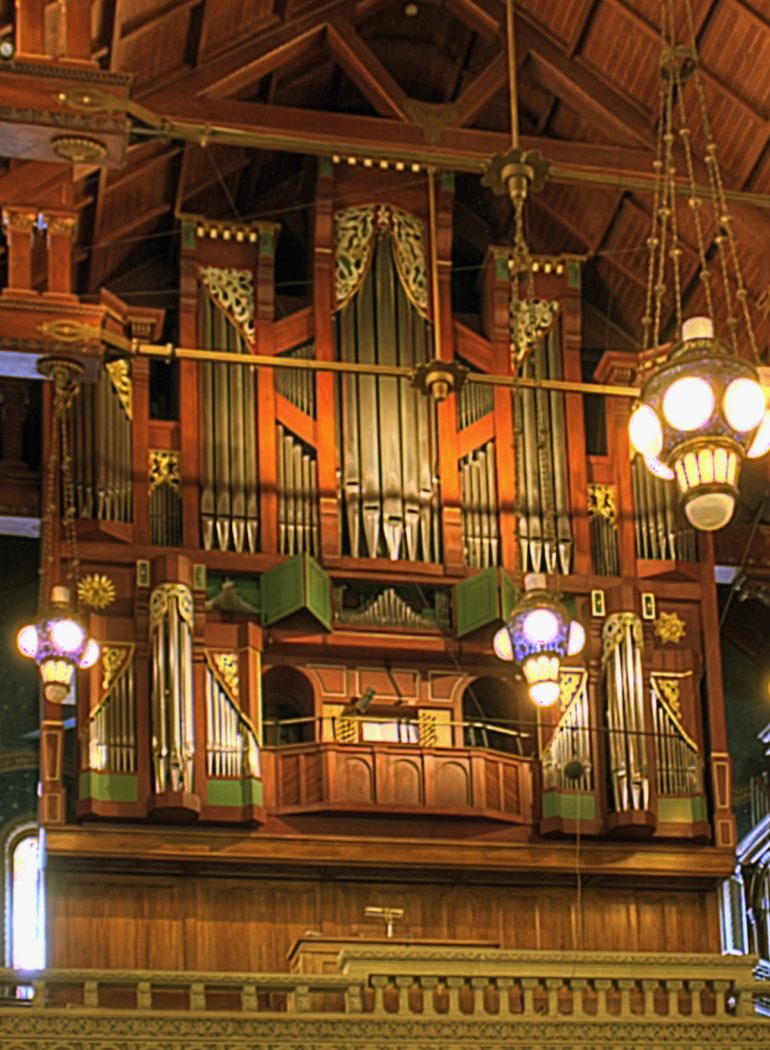
- phone: 978.283.1909
- email: cbfisk@cbfisk.com
Opus 85
Memorial Church, Stanford University
Stanford, CA
Created: 1984Opus 85 combines elements from the Renaissance and the Baroque. This dualism shaped the tonal design and extends to the tuning of this unique organ. By means of five additional pipes in every octave, a large lever can switch the Werk, Ruckpositive, Seitenwerk, and Pedal divisions from a Renaissance fifth-comma meantone to a well-tempered tuning like those J. S. Bach knew. The Brustpositive and the Brustpedalia are fixed in meantone and offer two sub-semitones, or split sharps, per octave, D sharp/E flat and G sharp/A flat. Meantone tuning expert Harald Vogel worked closely with Charles Fisk during the development of this system and shared much valuable knowledge.
The Brustpositive is centered above the console; to the left and right are the halves of the Brustpedalia. Hand-operated doors for the Brust openings allow for dynamic control. The three large towers and two flats overhead contain the Great, or Werk, with 16′ C of the Prestant in the center. The two smaller outside towers and the flats connecting them to the main case enclose the Seitenwerk, an Oberwerk on the sides of, rather than above, the Werk. The Rückpositive is divided between two cabinets at console level cantilevered beside the organist’s platform.
The case is of red-stained poplar. The natural keys are grenadil and the accidental keys are rosewood capped with bone. The polychrome and gilt pipe shades designed and carved by Roger Martin are both functional and decorative and feature a sea motif connecting the organ’s origin in Gloucester to its home near the west coast.
Opus 85 is the last organ that Charles Fisk saw in the workshop. After a three-month installation at Stanford, the crew took photographs to show him this very special instrument in its new home. To the great grief of everyone in the shop, he died December 16, 1983, the day before the crew returned to Gloucester.
Werk, Man II
CC-f3, (54 keys, 71 pipes)
Prestant 16′
Quintadehn 16′
Octava 8′
Spillpfeife 8′
Violon 8′
Quinta 5 1/3′
Octava 4′
Superoctava 2′
+Quinta 2 2/3′
+Cornet III
Mixture VIII-XIV
Trommeten 16′
Trommeten 8′
Trompette 8′
Clairon II 4′
Rückpositiv, Man I
CC-f3, (54 keys, 72 pipes)
Prestant 8′
Gedackt 8′
Quintadena 8′
Octava 4′
Rohrflöte 4′
+Quinta 2 2/3′
+Sesquialter II
+Superoctava 2′
+Mixture V-IX
Dulcian 16′
Cromorne 8′
Trechterregal 8′
Seitenwerk, Man III
CC-f3, (54 keys, 71 pipes)
Principal Schwiegel 8′
Rohrflote 8′
Holzoctava 4′
+Doublette 2′
+Cornet III
+Sifflöte 1′
+Mixture IV
Vox humana 8′
Brustpositiv, Man IV
CC-c3 (52 keys, 52 pipes)
Gedackt 8′
Quintadehn 4′
Waldflöte 2′
Doppelt Cimbel II
Regal 8′
Schalmey 4′
Brustpedalia
(30 keys, 40 pipes)
Jungfrauenregal 4′
Cornett 2′
Bauernflöte 1′
Pedal
(30 keys, 40 pipes)
+Contra Bourdon 32
+Subbass 16′ Prestant 16′ from Werk
*Quintadehn 16′
*Octava 8′
*Spillpfeife 8′
*Violon 8′
*Quinta 5 1/3′
*Octava 4′
*Superoctava 2′
Contraposaune 32′ Posaune 16′ from 32′
Trompete 8′ from 32′
*Trommeten 8′
*Trompette 8′
*Clairon II 4′
Couplers:
Manual Shove Couplers:
Rückpositive to Werk
Seitenwerk to Werk
Pedal Couplers:
Werk to Pedal
Rückpositive to Pedal
Accessories:
Tremulant
Wind Stabilizer
Well tempered or one-fifth comma meantone tuning systems for everything except the Brustpositiv which is in one-fifth comma meantone with sub-semitones g# & ab, eb & d# and a short octave with FF# & GG#.
In bracketed pairs of stops above, drawing the knob halfway brings on the first stop and drawing the knob fully brings on the second stop.
* Stops in common between Werk & Pedal are available from a single knob. Pulling the knob out to its half draw causes the stop to play in the Werk, drawing it out fully causes the stop to play in the Pedal. Drawing the Werk to Pedal coupler allows the stop to play in both divisions if drawn in the Werk.
